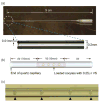Ultra-rapid vitrification of mouse oocytes in low cryoprotectant concentrations
- PMID: 20113958
- PMCID: PMC2818866
- DOI: 10.1016/j.rbmo.2009.11.012
Ultra-rapid vitrification of mouse oocytes in low cryoprotectant concentrations
Abstract
The ideal cryopreservation protocol would combine the benefits of slow freezing with the benefits of vitrification. This report describes a method for the ultra-rapid vitrification of oocytes using slush nitrogen in quartz capillaries. The approach minimizes the thermal mass of the vitrification vessel by using open microcapillaries made of highly conductive quartz and achieves cooling rates of 250,000 degrees C/min. The process of vitrification can be optimized by maximizing the rate at which the sample is cooled, which allows for the use of lower cryoprotectant concentrations. Mouse oocytes can be successfully vitrified using 1.5 mol/l 1,2-propanediol and 0.5 mol/l trehalose and achieve survival rates of 90.0%(36/40). Fertilization and blastocyst formation rates of vitrified-warmed and fresh oocytes were not significantly different. A total of 120 blastocysts from each of the vitrified-warmed and fresh oocytes were transferred to surrogate mothers and 23 and 27 offspring were born respectively. All offspring in both groups were healthy, grew and bred normally and gave rise to a second generation of pups. Thus, an ultra-rapid vitrification technique has been developed for mouse oocytes that uses low concentrations of cryoprotectants and slush nitrogen in quartz capillaries, which combines the benefits of slow freezing and vitrification.
2009 Reproductive Healthcare Ltd. Published by Elsevier Ltd. All rights reserved.
Conflict of interest statement
Declaration: Dr J Biggers is a consultant to IVFonline LLC, Guelph, Canada. The other authors report no financial or commercial conflicts of interest.
Figures


Similar articles
-
Improved low-CPA vitrification of mouse oocytes using quartz microcapillary.Cryobiology. 2015 Jun;70(3):269-72. doi: 10.1016/j.cryobiol.2015.04.003. Epub 2015 Apr 11. Cryobiology. 2015. PMID: 25869750 Free PMC article.
-
Cryopreservation of human failed-matured oocytes followed by in vitro maturation: vitrification is superior to the slow freezing method.Reprod Biol Endocrinol. 2011 Dec 12;9:156. doi: 10.1186/1477-7827-9-156. Reprod Biol Endocrinol. 2011. PMID: 22151887 Free PMC article.
-
Cryopreservation of Mammalian Oocytes: Slow Cooling and Vitrification as Successful Methods for Cryogenic Storage.Methods Mol Biol. 2021;2180:437-454. doi: 10.1007/978-1-0716-0783-1_20. Methods Mol Biol. 2021. PMID: 32797426
-
Effect of type of cryoprotectant on morphology and developmental competence of in vitro-matured buffalo (Bubalus bubalis) oocytes subjected to slow freezing or vitrification.Reprod Fertil Dev. 2008;20(4):490-6. doi: 10.1071/rd07203. Reprod Fertil Dev. 2008. PMID: 18462611
-
A critical appraisal of cryopreservation (slow cooling versus vitrification) of human oocytes and embryos.Hum Reprod Update. 2012 Sep-Oct;18(5):536-54. doi: 10.1093/humupd/dms016. Epub 2012 Apr 25. Hum Reprod Update. 2012. PMID: 22537859 Review.
Cited by
-
"Universal" vitrification of cells by ultra-fast cooling.Technology (Singap World Sci). 2015 Mar;3(1):64-71. doi: 10.1142/S2339547815500053. Technology (Singap World Sci). 2015. PMID: 25914896 Free PMC article.
-
Impact of prolonged oocyte incubation time before vitrification on oocyte survival, embryo formation, and embryo quality in mice.In Vitro Cell Dev Biol Anim. 2017 Jun;53(6):525-531. doi: 10.1007/s11626-017-0130-9. Epub 2017 Feb 3. In Vitro Cell Dev Biol Anim. 2017. PMID: 28160207
-
Ice formation and its elimination in cryopreservation of oocytes.Res Sq [Preprint]. 2024 May 23:rs.3.rs-4144933. doi: 10.21203/rs.3.rs-4144933/v1. Res Sq. 2024. Update in: Sci Rep. 2024 Aug 13;14(1):18809. doi: 10.1038/s41598-024-69528-8. PMID: 38826214 Free PMC article. Updated. Preprint.
-
Emerging technologies in medical applications of minimum volume vitrification.Nanomedicine (Lond). 2011 Aug;6(6):1115-29. doi: 10.2217/nnm.11.71. Nanomedicine (Lond). 2011. PMID: 21955080 Free PMC article.
-
Improved low-CPA vitrification of mouse oocytes using quartz microcapillary.Cryobiology. 2015 Jun;70(3):269-72. doi: 10.1016/j.cryobiol.2015.04.003. Epub 2015 Apr 11. Cryobiology. 2015. PMID: 25869750 Free PMC article.
References
-
- American Society for Reproductive Medicine, Practice Committee of Society for Assisted Reproductive Technology. Ovarian tissue and oocyte cryopreservation. Fertility and Sterility. 2008;90 (5 Suppl):S241–246. - PubMed
-
- Berejnov V, Husseini NS, Alsaied OA, Thorne RE. Effects of cryoprotectant concentration and cooling rate on vitrification of aqueous solutions. Journal of Applied Crystallography. 2006;39:244–251.
-
- Bernard A, Fuller BJ. Cryopreservation of human oocytes: A review of current problems and perspectives. Human Reproduction Update. 1996;2:193–207. - PubMed
-
- Biggers JD, McGinnis LK, Raffin M. Amino acids and preimplantation development of the mouse in protein-free potassium simplex optimized medium. Biology of Reproduction. 2000;63:281–293. - PubMed
-
- Chen SU, Lien YR, Chao KHHo, et al. Effects of cryopreservation on meiotic spindles of oocytes and its dynamics after thawing: clinical implications in oocyte freezing–a review article. Molecular and Cellular Endocrinology. 2003;202:101–107. - PubMed
Publication types
MeSH terms
Substances
Grants and funding
LinkOut - more resources
Full Text Sources
Other Literature Sources

